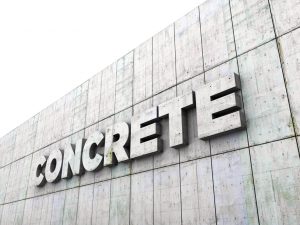Employing the correct fastener in repairs or constructions is essential for the structural security of the project. To ensure a reliable connection, it is mandatory that the fastener fits into the hole perfectly. The reason for this stems from the fact that the installation of concrete fasteners typically implies smashing the bottom until it expands and it can grip the entire surface of the hole. Let’s summarize the most common fasteners utilized in concrete applications.

- Wedge anchors
While it is true that wedge anchors have a similar appearance to headless bolts, the difference resides in the conical hollow bottom of the former, hence the name. Wedged anchors are typically installed into hardened cement and ensure a snug hold due to the design of the sides that grip the concrete around a predrilled hole. The installation entails placing the fastener at the bottom of a hole and pounding its tip until the wedge is crushed. The compression leads to the expansion of the wedge that grips the sides of the hole. Wedge anchors constitute an ideal choice for applications that imply heavy bearing loads.
- Anchor bolts
Irrespective of the type of anchor bolts used, be it S-shaped, J-shaped or straight, these fasteners are typically embedded into wet cement. To be more precise, immediately after a concrete pour, engineers position, entrench and secure the anchor bolts into the wet material. Once the cement hardens, the bolts provide a dock for structural components such as load-bearing walls, while the concrete ensures a firm grasp of the fasteners in place. Anchor bolts can also be inserted into hardened cement, although the process implies drilling holes and securing the fastener with specially formulated epoxy compounds.
- Sleeve anchors
Similar to wedge anchor, sleeve anchors look like a headless bolt with a hollow bottom. Moreover, the installation is basically the same: the sleeve anchor is placed in a predrilled hole and smashed so that the base splits the sleeve and makes it grip the sides of the gap. The differences between the two come from the strength and resilience of the conical tip as well as the metal sleeve located around the shank.
- Drop-in anchors
As the name suggests, drop-in anchors consist of a bolt and an empty metallic cylinder, which is sealed at one side and open on the other. Because the sealed end is hollow, installing it is similar to sleeve and wedge anchors. After the anchor is set in place, the engineers thread the corresponding bolt into the fastener’s cavity.
- Concrete screws
Similar to inserting screws into wood, concrete screws require a preexisting hole of the same diameter as the smooth portion of the shank. Attempting to drive in the screw too deeply, meaning trying to insert the threaded part into the hole, can lead to cracks in the cement. While it is true that they’re cheaper and easier to install compared to anchors, the truth is that they’re also weaker than the aforementioned fasteners. Moreover, concrete screws should never be employed for securing structural components or for supporting heavy objects.
